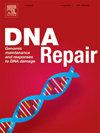DNA修复缺陷在脂质积累中的作用:一项概念验证研究
IF 2.7
3区 生物学
Q2 GENETICS & HEREDITY
引用次数: 0
摘要
动物模型表明,碱基切除修复(BER)缺陷与肥胖风险增加之间存在关联。为了研究BER缺乏对细胞内脂质积累的影响,我们在体外BER敲低(KD)模型中研究了代谢活性,目标是MutY DNA糖基化酶(MUTYH)、Nth样DNA糖基化酶1 (NTHL1)和8-氧鸟嘌呤DNA糖基化酶(OGG1)。我们假设将BER缺陷细胞暴露于脂质会导致线粒体功能降低和细胞内脂质积累增强。利用慢病毒shrna在HepG2细胞中生成稳定的BER KD模型。KD用qRT-PCR确认,BER活性用改良comet法测定。暴露于油酸和棕榈酸混合物后,DNA损伤和线粒体拷贝数仅在NTHL1-KD细胞中发生改变,但通过Oil-Red-O (ORO)染色发现,与lacZ对照细胞相比,所有KD细胞积累了更多的细胞内脂质。与对照细胞相比,暴露于脂肪酸混合物中MUTYH-KD细胞的质子泄漏增加,表明线粒体功能受损。此外,当暴露于脂肪酸混合物时,所有KD细胞都表现出β-氧化活性降低。总的来说,这项研究表明,BER缺陷的HepG2细胞更容易积累脂质,这与线粒体功能受损有关。这些发现与理解调节一个人积累脂质的敏感性和增加他们患代谢性疾病(如肥胖和脂肪肝疾病)风险的潜在机制有关。本文章由计算机程序翻译,如有差异,请以英文原文为准。
The role of DNA repair deficiency in lipid accumulation: A proof-of-concept study
Animal models suggest an association between base excision repair (BER) deficiency and increased risk of obesity. To mechanistically investigate the effect of BER deficiency on intracellular lipid accumulation, we studied metabolic activity in in vitro BER knockdown (KD) models, targeting MutY DNA Glycosylase (MUTYH), Nth Like DNA Glycosylase 1 (NTHL1) and 8-Oxoguanine DNA Glycosylase (OGG1). We hypothesized that exposing BER deficient cells to lipids leads to reduced mitochondrial function and enhanced intracellular lipid accumulation. Stable BER KD models were generated in HepG2 cells using lentiviral shRNAs. KD was confirmed by qRT-PCR and BER activity was assessed using a modified comet assay. Upon exposure to a mixture of oleic and palmitic acid, DNA damage and mitochondrial copy number were only altered in NTHL1-KD cells, but all KD cells accumulated more intracellular lipids compared to lacZ control cells as determined by Oil-Red-O (ORO) staining. Compared to control cells, exposure to the fatty acid mixture increased proton leak in MUTYH-KD cells, indicating impaired mitochondrial function. Moreover, all KD cells showed reduced β-oxidation activity when exposed to the fatty acid mixture. Overall, this study shows that BER deficient HepG2 cells are more prone to accumulated lipids, which was associated with impaired mitochondrial function. These findings are relevant in understanding the underlying mechanisms that modulate the sensitivity of a person to accumulate lipids and increase their risk of developing metabolic diseases such as obesity and fatty liver disease.
求助全文
通过发布文献求助,成功后即可免费获取论文全文。
去求助
来源期刊

DNA Repair
生物-毒理学
CiteScore
7.60
自引率
5.30%
发文量
91
审稿时长
59 days
期刊介绍:
DNA Repair provides a forum for the comprehensive coverage of DNA repair and cellular responses to DNA damage. The journal publishes original observations on genetic, cellular, biochemical, structural and molecular aspects of DNA repair, mutagenesis, cell cycle regulation, apoptosis and other biological responses in cells exposed to genomic insult, as well as their relationship to human disease.
DNA Repair publishes full-length research articles, brief reports on research, and reviews. The journal welcomes articles describing databases, methods and new technologies supporting research on DNA repair and responses to DNA damage. Letters to the Editor, hot topics and classics in DNA repair, historical reflections, book reviews and meeting reports also will be considered for publication.
 求助内容:
求助内容: 应助结果提醒方式:
应助结果提醒方式:


